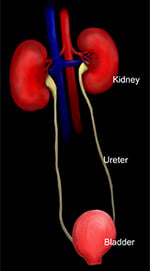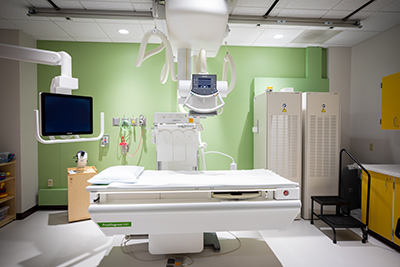Voiding Cystourethrogram (VCUG) After a Urodynamic Study

Your child’s doctor has requested a test called a voiding cystourethrogram (VCUG). This information will help prepare you and your child for a VCUG. A VCUG helps your child’s doctor learn more about your child’s bladder, ureters and kidneys. The body produces urine (pee) from the kidneys. The urine goes through the ureters and into the bladder. Some children have urinary reflux. Reflux happens when the urine flows from the bladder and goes back into the ureters and/or kidneys. Reflux can cause urinary problems, such as urinary tract infections (UTIs). Not all children with UTIs have reflux. A VCUG will show if urine is going in the right direction.
The VCUG process

- After the Urodynamic study, we will take you and your child to Radiology for the VCUG.
- You will go to the fluoroscopy room where the test will be done.
- Next, your child will lay down on the table in the room. They have blankets to help keep your child warm and covered up. You can stand right by your child during the test. You will need to wear a special lead apron.
- A technologist (tech) will connect the end of the catheter to a bottle of clear liquid, called contrast. They will use the urinary catheter that was placed during your child’s urodynamic study.
- Next, a doctor called a radiologist will come into the room and talk to you and your child about the test. The radiologist will move a camera that looks like a small tent over your
child’s tummy area. It will come close to their body, but it will not touch or hurt them. - Then, the contrast will slowly begin to fill your child’s bladder while the radiologist takes pictures of your child’s bladder and kidneys. It does not hurt when the contrast goes in, but your child may start to feel uncomfortable or like they need to pee. Your child needs to hold their pee as long as possible. You will be able to see the pictures on a TV screen by the table as the radiologist takes them.
- Your child may be asked to roll onto each side to have pictures taken.
- Once your child’s bladder is full, they will pee in a bedpan or urinal while still laying down on the X-Ray table. The tech will loosen the tape on the catheter so it can slide out while your child is peeing.
- Once your child’s bladder is empty, they can get off the bed and get dressed.
Helpful tips
- Watch our preparation video with your child, “Getting a VCUG at Children’s Mercy.” When watching the video, please keep in mind your child will already have a catheter from their urodynamic study:
- A child life specialist can help your child learn more about getting a VCUG and provide support.
- Your child can bring a comfort item (doll, stuffed animal, pacifier, blanket) and a distraction item (tablet, video game, favorite book). We have distraction items available as well.
- You can be in the room with your child the whole time during the VCUG. This is important and helps your child cope.
- If you are pregnant, please bring another adult to be with your child. Pregnant mothers are encouraged not to stay in the room during X-rays.
- Be prepared to focus on your child. Please do not bring any other children. Other children are not allowed in the room during the VCUG.
- Your child can eat and drink before their VCUG unless your child’s doctor gives you different instructions.
- Please plan for your child’s VCUG to take 30 to 60 minutes. The amount of time the VCUG takes is different for each child.
- After the VCUG, your child should drink plenty of fluids, like water and juice.
- You know your child best. Please let us know how we can help your child during their VCUG.
Questions?
If you have questions or information that you would like to share before your child’s VCUG, call (816) 234-3678. Please leave a message and a Children’s Mercy staff member will call you back as soon as possible.
